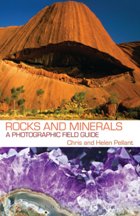Rocks and Minerals: A Photographic Field Guide
 Chris and Helen Pellant
Chris and Helen Pellant
Bloomsbury, £12.99
This compact guide fits easily into a pocket so you can carry it around with you. The introduction is followed by a description of the three rock types, although they do not have a set of common criteria due to the complexities of formation. For example, igneous rocks are partly classified (and identified) through the characteristics of their grain size, texture and composition.
On the other hand, metamorphic rocks are identified according to three groups that reflect how they were formed, while sedimentary rocks are the easiest to distinguish as a type because of their classic stratified appearance. Each rock type has colour images, but they are not linked to specific text. For example, on page 36, five images seem to have been placed randomly and without a clear link to the written information.
The minerals section follows, with an introduction outlining their nature, including the crystalline characteristic of many and a list of identification criteria with explanations. From page 76 to the glossary and index, minerals are described according to their main chemical composition – for example, emerald within the silicates – together with a colour plate, a descriptive table and common uses.
To say this is a field guide belies the fact that much of it reads more like a reference textbook. Additionally, the examples for minerals are drawn from across the globe and so the 'field' as such would need to be extensive. In other words, it wouldn't be that useful when investigating the minerals of any one country, yet it is a useful field guide to rocks, particularly those of the UK with the information being transferable to other countries.


